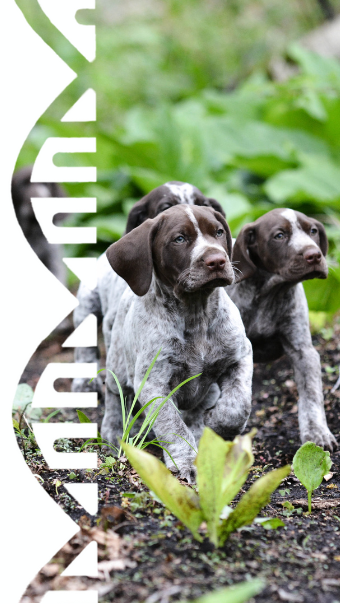 With the start of the New Year comes new beginnings and thoughts turn to planning for future litters. One of the most common questions we get when people are thinking about breeding pairs is how to predict what the puppies will be for different genetic diseases and coat colors. The answer is that it all comes down to breeding probabilities that can be calculated when you know the genetic status of each parent.
With the start of the New Year comes new beginnings and thoughts turn to planning for future litters. One of the most common questions we get when people are thinking about breeding pairs is how to predict what the puppies will be for different genetic diseases and coat colors. The answer is that it all comes down to breeding probabilities that can be calculated when you know the genetic status of each parent.
For many people, probability can be a confusing concept so let’s start with a more straightforward example of flipping a coin that has one side heads and one side tails. For every flip, you have an equal 50% chance of getting either heads or tails. So, what would your chances be for flipping two heads in a row? Since you have a 50% chance each time you flip, for two flips it would be 50% x 50% which would be a 25% chance of flipping two heads in a row. If you continue to flip the coin, your chances of getting heads each time get lower and lower but it never goes to zero. In theory, you could flip a coin 100 times and get heads every time but it is very unlikely. If you want to know your chances multiply 50% by itself 100 times and you’ll find it’s a very small number. A good way to think about probability is that it is the likelihood that an event will occur. For something that only has two outcomes, getting the same outcome over and over again becomes less likely each time but is not impossible.
So, what does flipping a coin have to do with breeding? To answer this question, we need to cover a little biology background. Unlike other cells in the body that have two copies of each gene, every sperm and egg cell that come together to make a puppy has only a single gene copy in each. For a homozygous dog (both gene copies are identical), every sperm for males or every egg for females has the same gene copy and imparts the same genetic information regardless of which sperm or egg ends up making the puppy. This would be similar to having a two-headed coin that would give you the same result no matter how many times you flipped it. Heterozygous dogs (gene copies are different) have one gene copy that has the mutation and one gene copy that doesn’t. If you were able to look at the sperm or eggs from a heterozygous dog you would find that 50% of the sperm or eggs have a clear gene copy and 50% have the mutation. This creates a scenario the same as flipping a coin where you have a 50% chance of either outcome.
When trying to predict the outcome for a litter, the first step is to know the genetics of the breeding pair. Certain combinations will give you a known outcome every time. This includes a clear to clear breeding which results in all clear puppies, an affected to affected breeding which results in all affected puppies, and a clear to affected breeding which results in all carriers as illustrated in the following Punnett Squares:

The result for all other breeding combinations will not necessarily be the same each time and can be predicted based on probability. This is because when breeding a carrier parent to any other parent, the carrier dog has a 50% chance of contributing either the clear or mutated gene copy to each puppy. This is because 50% of the egg or sperm have the mutated gene copy. So, similar to flipping a coin, there is a 50% chance each puppy will get a clear copy or a mutated copy. It just depends on which sperm gets to which egg first. The typical results for different carrier breeding combinations are illustrated in the following Punnett Squares:

Although the above is a good guide on what to expect on average, remember that similar to flipping a coin, it is possible to get other less likely results when breeding a carrier. Breeding probabilities apply regardless of whether you are testing for disease, coat color, coat type, or anything else. We are always available for questions and we are happy to help you make predictions for your next litter. By working together, we can continue to support pet health through fast, accurate, and affordable testing and good breeding decisions.

